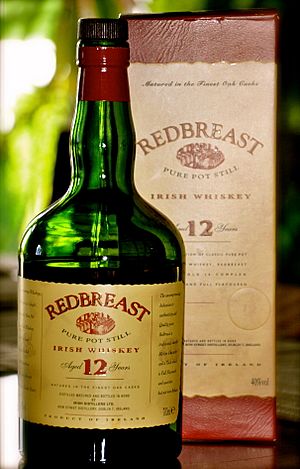Single pot still whiskey facts for kids
 |
|
| Type | Whiskey |
|---|---|
| Country of origin | Ireland |
| Alcohol by volume | Minimum 40% |
| Colour | Pale Gold to Dark Amber |
Single pot still whiskey is a special kind of Irish whiskey. It is made at just one distillery. This whiskey uses a mix of both malted (sprouted) and unmalted (raw) barley. It is always distilled in a large container called a pot still. This unmalted barley gives the whiskey a unique spicy taste and a rich, thick texture. If the whiskey is made at more than one place, it cannot be called "single pot still."
This type of whiskey was once very popular around the world. In the past, people called it "pure pot still whiskey" or just "pot still whiskey." The name "single pot still" was introduced more recently. This happened because of rules in the United States about using the word "pure" on food and drink labels. It's important not to confuse this specific style with just any whiskey made in a pot still.
Contents
How Whiskey is Made: The Science of Distillation
Making whiskey involves a process called distillation. This process helps separate different parts of a liquid mixture. Imagine you have a mix of liquids, like water and alcohol. They have different boiling points. When you heat the mixture, the part with the lower boiling point turns into a gas first.
The liquid mixture, called "wash," is poured into a large container. This container is usually made of copper and is called a still. Steam is used to heat the still. The wash contains many things, like water, alcohol, and parts from the barley. The goal is to separate the alcohol and other chemicals.
As the still heats up, the alcohol and some other chemicals turn into a gas. This gas then travels up and into another tube. Cold water flows around this tube, making it very cold. When the gas touches the cold tube, it turns back into a liquid. This new liquid, which is now much stronger in alcohol, is collected in a separate container.
Inside the still, a special stirrer called a rummerger keeps the wash moving. This stops any solid bits from burning at the bottom. Even after the first step, some barley solids remain. During heating, molecules move faster. When they turn into gas, they spread out more. When they cool down, they slow down and come closer together, turning back into liquid. This process helps create the unique flavors of the whiskey.
A Look Back: The History of Single Pot Still Whiskey
Whiskey has been made in Ireland for a very long time, possibly since the 6th century. Single pot still whiskey became popular because of a tax. In 1785, a tax was put on malted barley. To avoid this tax, distillers started using unmalted barley in their whiskey. Even after the tax was removed in 1855, people still loved this style.
In the 1800s, single pot still whiskey was the most popular type of whiskey in the world. Most of Ireland's whiskey exports were this style. However, in the 1900s, cheaper and milder blended whiskeys became popular. This caused single pot still whiskey to lose its fame. Many brands that once made only pot still whiskey started making blends instead.
By 1980, only two special single pot still whiskeys were still made: Green Spot and Redbreast. One of them was even close to being stopped. But in recent years, Irish whiskey making has grown again. This has led to many new single pot still whiskeys being released.
What Makes it Official: Legal Rules for Irish Pot Still Whiskey
There are specific rules for making Irish pot still whiskey. These rules are in addition to the general rules for all Irish whiskey, like needing to be made in Ireland and aged in wooden barrels for at least three years.
For Irish pot still whiskey, the rules say it must be:
- Made from a mix of malted barley, unmalted barley, and other unmalted grains.
- Distilled in a pot still. This makes sure the whiskey has the right smell and taste from the ingredients.
- Made with at least 30% malted barley and at least 30% unmalted barley.
Also, the rules state:
- Up to 5% of other grains, like oats or rye, can be used.
- It can be distilled two or three times. Traditionally, most Irish pot still whiskey is distilled three times.
- The word "single" can be added if the whiskey is made at only one distillery.
Types of Single Pot Still Whiskeys
As of 2018, there are a few single pot still whiskeys available. More are expected to come out soon, as many new distilleries have opened in Ireland.
Here are some examples you might find:
- Dingle Single Pot Still (first released in late 2017)
- Green Spot, Yellow Spot, and Red Spot
- Method & Madness Single Pot Still
- Midleton (like Barry Crockett Legacy, Dair Ghaelach)
- Powers (such as Three Swallows, Signature Release, John's Lane)
- Redbreast (including 12, 12 Cask Strength, 15, 21, Lustau Edition)
- Teeling Single Pot Still (released in August 2018)


